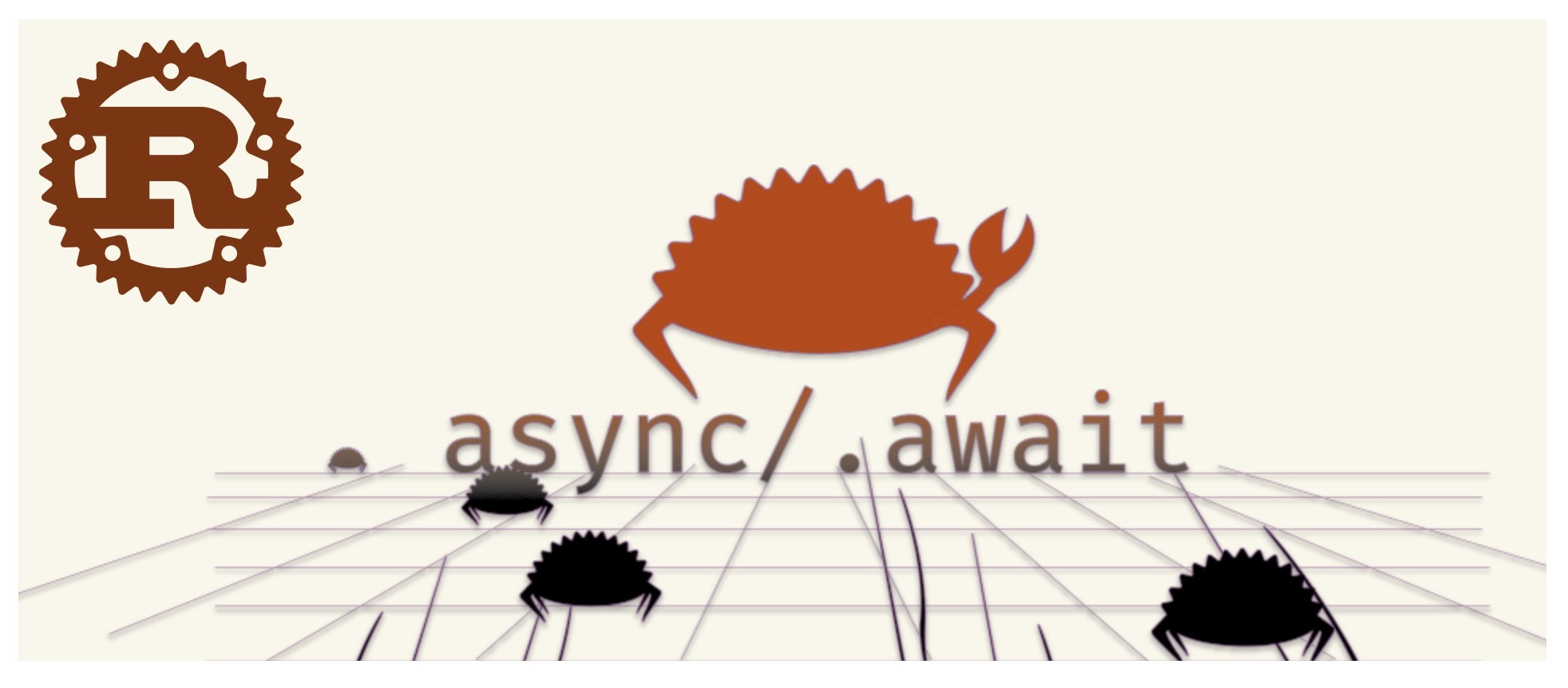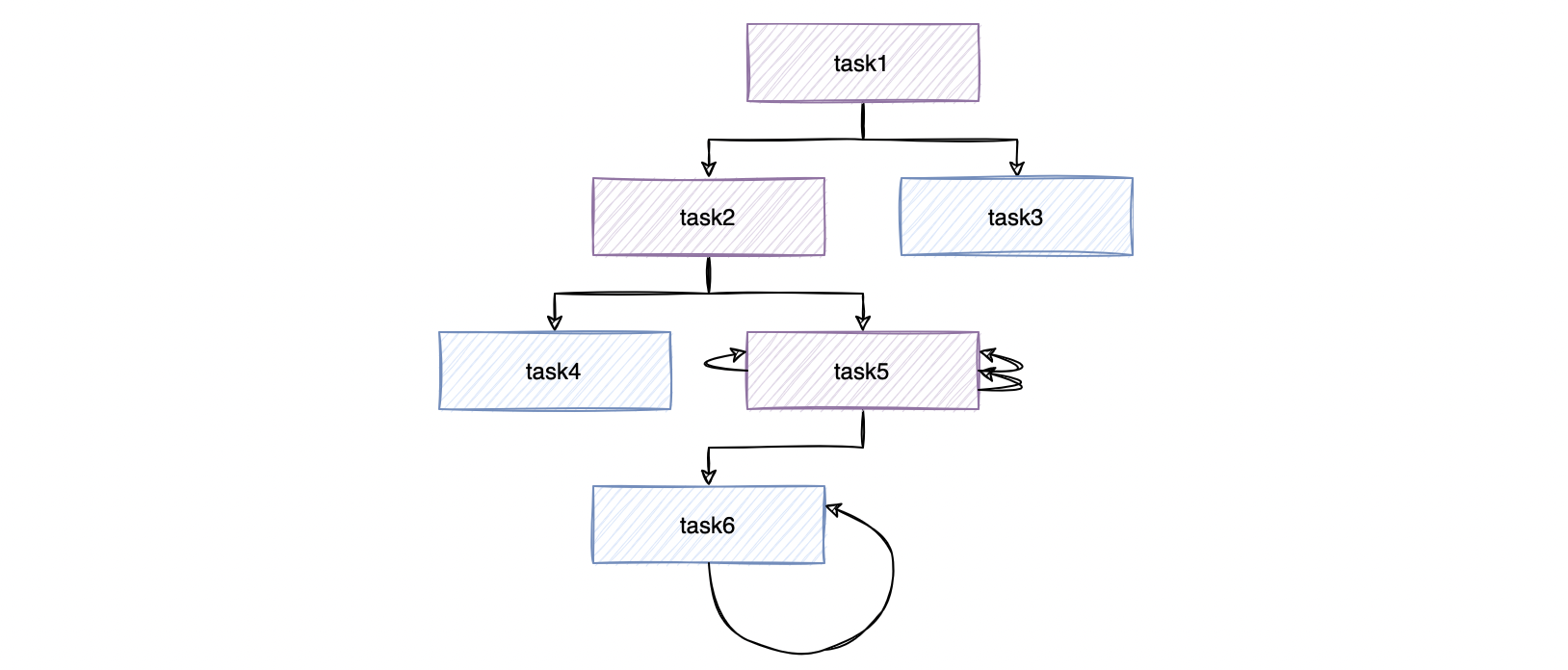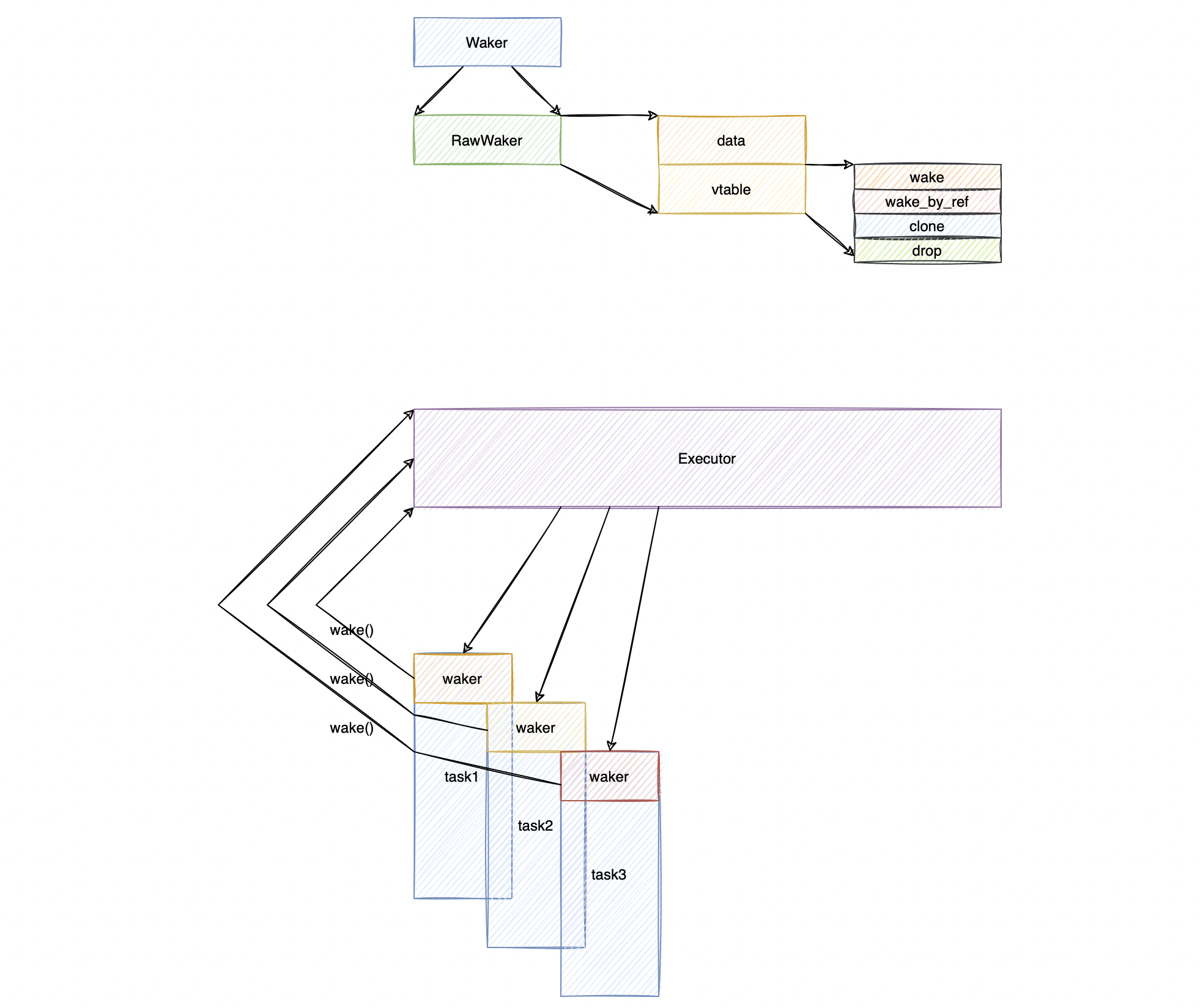前言
Rust 于 2018 年引入异步,四年后的今天,我第一次接触 Rust 且使用 async/await 实现了一个小的 IM(即时通讯)系统,带着原本对于 Rust 的好奇和对于异步的疑惑,翻阅了一些文章和参考,最后得到了一些答案。
在阅读之前,希望读者:
有限自动状态机
又称状态机,简称fsm,讨论一般情况,一个状态机系统由四个元素组成:
状态:State
事件:Event,或者条件,指令
行为:Action,或者函数,方法
转换:Transfer
以自动门的开关为例,可以画出如下状态机转换图:
Rust 对于异步的实现依赖于状态机。
IO 多路复用
Linux/macOS/Windows 等系统对于非阻塞 IO 的实现为 Epoll/Kqueue/IOCP,其中 IOCP 支持异步非阻塞 IO。以上称为“多路复用 IO”,旨在减少因为等待 IO 而造成的大量线程创建,提高系统连接数。具体细节这里不会进行阐述。
异步
关于更好地实现 IO 密集型 App 的吞吐量和 CPU 利用率,程序并行化的过程经历了:多进程=>多线程=>协程/异步 这样的发展趋势。来看不同语言的实现:
其中协程分为:
异步则是协程的一种变种,Rust 中选用了这种形式,并且贴近于无栈协程,具体后面会展开。
Rust 的异步无法直接运行,依赖于运行时进行调度,由于官方的运行时性能欠缺,所以更多使用的是 Tokio,具体见 Tokio 文档。
Rust 仅仅定义了异步 Task 的生成和异步的唤醒方式,并没有定义异步的调度,对于底层操作的封装(比如 IO,定时器,锁等)和唤醒器的实现,所以这就给第三方提供了很多的可能,也为我们自己实现自己的异步运行时提供了机会。
概述
生成器
前面提到,Rust 的异步类似于无栈协程,而 Rust 早期对于异步的尝试,则是通过 Generator 的形式实现的。在 Python,JavaScript 等语言均可以见到生成器的身影,Generator。
具体来说,生成器负责生成执行体(或者执行函数),一个执行体由可执行代码和数条 yield 语句组成,每一个 yield 把执行体切分成了不同的执行阶段。对于执行体的执行,会从上一次中断位置执行,直到遇到下一个 yield(又或者称为中断点/保存点)位置,此时会保存执行体的执行状态,包括更新之后的局部变量等。
通过上述描述,可以想到这和线程切换有些类似,如果把每一个线程看成一个可执行的片段,那么线程切换也是需要保存上下文,进行下一个线程的切换(执行片段的切换,不过执行片段是向同一个方向推进的,线程则是由调度算法决定下一个执行的目标)。
理解到这里,就理解了大致的生成器使用原理。
Rust 也曾经使用这种方式来处理异步,但是因为 Rust 的生命周期和借用规则的存在,导致跨 yield 保存上下文实现起来比较困难,所以改进之后得到了现在的 async/await,即生成器是 Rust 异步的前身,后面会详细叙述这一点。
Rust 中对于生成器有两个主要的定义:
pub trait Generator<R = ()> { type Yield;
type Return;
fn resume(self: Pin<&mut Self>, arg: R) -> GeneratorState<Self::Yield, Self::Return>;}
pub enum GeneratorState<Y, R> { Yielded(Y),
Complete(R),}
复制代码
这里的GeneratorState则是对应了执行体的状态,每一个 yield 中断点都会得到一个GeneratorState::Yielded的枚举值,而执行体结束之后,则会得到一个GeneratorState::Complete枚举值。
此外注意到,Generator::resume()的返回值对应了GeneratorState,侧面说明这个方法负责推进执行体的执行。
至于编译器对于执行体的实现,下面会说。
为什么是生成器?异步哪里去了?
前面说生成器对于横跨保存点的引用处理会比较麻烦,所以优化处理之后得到了异步。在现在版本的 Rust 异步中,其实现和生成器的实现看起来差不多,而仅仅在某些名词或者执行推进方式上有所不同。此外对于 Future 的生成以及处理,是和编译器强耦合的,找到相关的文章或者源码,不太容易,涉及到的代码也仅是 LLVM-IR,所以我们借助生成器来理解并尝试使用生成器模拟一个异步定时器。
异步体系
Rust 的异步组件可以分为:
Future:会在未来返回某个值的执行体
Executor:执行器,负责推进 Future 的执行,调度多个 Future,响应 Future 的唤醒操作
Waker:针对某一 Future 绑定的唤醒器,用于当异步资源就绪时,唤醒执行器继续推进
Reactor:代表一些异步操作,比如网络,文件 IO,或者定时器等会在未来某个时间触发的行为
一般来说,异步面相 IO 密集型 App,所以一般来说 Reactor 就是最底层的 Future,其他的操作应该嵌套在 Reactor 操作之上。
如果按照这样的逻辑去划分,则 Future 可以分为两类:
这里给出一个图片:
蓝色的则是包含 Reactor 的叶子 Future,紫色的是嵌套了其他 Future 的非叶子 Future;上图中的箭头循环的含义后面解释。
细节
Generator
上面提到了 yield 机制,来看看 Rust 对于生成器生成的执行体,具体编译成了什么样的实现。
前文提到状态机是不可缺少的部分,而针对每一个 yield,都会生成一个具体的状态,并在状态里保存当前上下文,具体来说就是在枚举值里保存当前执行体涉及到的变量。
在这里我们手动来实现一个执行体的运行,通过硬编码模拟编译器生成的结果,然后手动调用 resume,推动状态的切换,以此达到执行体的阶段性执行。
请确保你的 Rust 为 Nightly 版本:
use std::mem;use std::ops::Generator;use std::pin::Pin;use std::ptr::replace;use std::thread::{sleep, spawn};use std::time::Duration;
// same as std::ops::Generatortrait MyGenerator<ARG = ()> { type Yield; type Return; fn resume(self: Pin<&mut Self>, arg: ARG) -> MyGeneratorState<Self::Yield, Self::Return>;}
// same as std::ops::GeneratorStateenum MyGeneratorState<Y, R> { Yielded(Y), Complete(R),}
// fsm state setenum MyGeneratorCodeState { Start, // in code, we only use String ref, so text is just a referenced object. Yield1 { text: String, text_ref: *mut String, }, Yield2(String), Yield3(usize), End,}
impl MyGeneratorCodeState { fn new() -> Self { Self::Start }}
impl MyGenerator for MyGeneratorCodeState { // corresponding to text.len() in MyFuture type Yield = usize; type Return = ();
fn resume(mut self: Pin<&mut Self>, arg: ()) -> MyGeneratorState<Self::Yield, Self::Return> { match mem::replace(&mut *self, MyGeneratorCodeState::End) { MyGeneratorCodeState::Start => { // line 1 let mut s1 = "aaa".to_string(); // line 2 let s1_ref = &mut s1; // line 3 println!("curr str: {}", s1_ref); let len = s1_ref.len(); // line 4 *self = MyGeneratorCodeState::Yield1 { text: s1, text_ref: std::ptr::null_mut(), }; if let MyGeneratorCodeState::Yield1 { ref mut text, ref mut text_ref } = *self { *text_ref = text as *mut String; } MyGeneratorState::Yielded(len) } MyGeneratorCodeState::Yield1 { ref mut text, ref mut text_ref } => { let mut len = unsafe { (*(*text_ref)).len() }; // line 5 println!("curr length: {}", len); // line 6 unsafe { (*(*text_ref)).push_str("state3") }; // line 7 let s2 = unsafe { (*(*text_ref)).clone() }; let len = s2.len(); // line 8 *self = MyGeneratorCodeState::Yield2(s2); MyGeneratorState::Yielded(len) } MyGeneratorCodeState::Yield2(ref text) => { // line 9 println!("new str: {}", text); // line 10 *self = MyGeneratorCodeState::Yield3(text.len()); MyGeneratorState::Yielded(0) } MyGeneratorCodeState::Yield3(ref value) => { // line 11 println!("new length: {}", value); *self = MyGeneratorCodeState::End; // line 12 MyGeneratorState::Complete(()) } MyGeneratorCodeState::End => panic!("MyFuture polled after completion"), } }}
pub fn simulate() { // this is some generator code, and the fsm code above is compiler result of the code(just simulate). let mut generator_code = || { // line 1 let mut s1 = "aaa".to_string(); // line 2 let s1_ref = &mut s1; // line 3 println!("curr str: {}", s1_ref); // line 4 yield s1_ref.len(); // line 5, across yield reference println!("curr length: {}", s1_ref.len()); // line 6 s1_ref.push_str("state3"); // line 7 let s2 = s1_ref.clone(); // line 8, yield with new str: s2, but yield can only save one type, // so the `yield s2.len()` as save s2.len() will be transferred to `save s2` in resume method(). yield s2.len(); // line 9, across yield reference println!("new str: {}", s2); // line 10, yield with new str_length: s2.len() yield s2.len(); // line 11, across yield reference println!("new length: {}", s2.len()); // line 12 }; let mut gen = Pin::new(&mut generator_code); gen.as_mut().resume(());
// before you run code blow, remember to comment the code above, // case borrow across yield point is not allowed in Rust. // 运行代码之前记得注释掉前面的,因为yield使用借用会有问题
// to verify yield-simulate work, run the code blow. let mut gen = MyGeneratorCodeState::new(); let mut gen = Pin::new(&mut gen); gen.as_mut().resume(()); gen.as_mut().resume(()); gen.as_mut().resume(()); gen.as_mut().resume(());}
复制代码
上述代码中,我们在 simulate()中定义了一个生成器,并通过状态机解释了编译之后的结果,然后手动调用resume()方法,尝试切换状态,并以此推进执行,得到的输出和预期一致。
这里留意到出现了 Pin 和指针,而不是引用。关于为什么使用指针,是因为在需要使用引用时,生命周期无法工作,所以我们使用原生指针并手动控制指针的释放和获取。
此外 Pin 因于自引用的存在而存在,下面会提及。
Async/Await
前面说到 Rust 异步的实现和生成器的实现很像,都需要保存状态,都会分阶段运行,不同之处在于 async/await 实现了跨保存点引用,具体实现方式则是指针+Pin;而是用Pin的原因很简单,因为指针会产生自引用类型,需要 Pin 保证自引用类型的有效性。
在异步中,当触发保存点保存上下文时,如果出现了跨包存点的引用(因为 yield 保存的上下文其实是此语句后面的状态),则改为裸指针处理,并且把被指向的值一同保存在当前状态中(不然因为生命周期而导致被指向数据销毁,指针非法)。但是这就产生了自引用,所以需要 Pin 来固定。想象一下,如果这个值被移动,那么指针指向的数据也不再得到合法性保证了不是吗,所以最简单的方式就是不要让它移动。
Pin
Pin 的主要作用是保证被指向数据的不可移动,当尝试 move 一个被 Pin 修饰的变量时,会触发一个异常,关于 Pin 的实现则是由编译器进行保证,比较简单。
而想要实现 Pin 则在需要被 Pin 的类型上追加一个大小为 0 的标记字段,其类型为PhantomPinned。在 Rust 中,类型默认是Unpin的,即可以随便的move。包含了Pin字段的类型会自动实现Pin。
被 Pin 的指针根据指向数据的位置分为:
具体细节见Pinning。这里我们说一下 Pin 到底是什么?
首先 Pin 类型只有一个字段,即需要被固定的数据的可变引用类型。所以 Pin 固定的是某个引用背后的数据。
既然这里需要引用,那么构造得到的 Pin 实例的生命周期(关于对象和引用的生命周期详见之前的笔记)就不可以大于需要被固定的引用的生命周期。
堆上分配本身得到的就是一个引用,直接拿着这个引用去构造 Pin,得到的实例可以实现所有权转移,因为 Box 包含的数据不会被move,这里仅仅是移动了 Box 类型。而栈上数据会直接移动整个变量,这也是 Pin 在栈上和堆上的一点不同。
最后为了性能,给出一个建议就是,能 Pin 在栈上就 Pin 在栈上。除非本身就是 Pin 的或者想要在 Pin 之后依旧移动所有权(不是移动数据)。
Future
到目前为止,我们介绍了所有 Future 实现需要的细节:
剩下的就是对比 Future 和 Generator 然后硬编码尝试实现一个 Future。
当然还有一个调度和唤醒的细节,放在后面提及。
前面提及 Future 分为叶子 Future 和非叶子 Future,其中非叶子 Future 包含其他 Future,而非叶子 Future 的执行需要等待内嵌的 Future 的执行,即 xxx().await;而如果某个异步方法没有就绪,则需要释放 CPU 使用权,即**在当前.await位置yield**,然后等到就绪之后再次推进。
看!这是不是把 Future 和 Generator 对应起来了?**yield需要释放 CPU 保存执行上下文,同样无法推进的.await操作也需要释放 CPU,保存上下文**。
所以它们在实现上基本一致,也是通过状态机实现,每一个.await的成功推进对应一个状态的转移。同时在状态枚举值保存目前的上下文变量。
分析完非叶子节点,接下来是叶子结点的处理,叶子 Future 本身不包含任何.await操作,所以也就不存在保存上下文等编译器行为。
对它们的处理很简单,因为它们只会返回Poll::Pending/Poll::Ready两种结果,在调度器得到Poll::Pending结果时,切换到另一个 Future 即可。而在调度器被Waker唤醒时,重新执行叶子 Future 的poll()方法进行轮询。
所以这里的叶子 Future 在实现上最好把就绪检测放在poll()的开始,避免重复执行过多的不必要部分。
但是这里又有一个疑问,非叶子 Future 得到叶子 Future 的Poll::Pending结果之后,怎么处理呢?肯定不可能重新执行非叶子 Future 吧!那么最好就是在.await这里保存一下上下文,并且返回这个Poll::Pending结果,等到下次调用非 Future 的 poll()方法时,继续这个位置执行。这里给出一个可能的实现:
async fn poll() { aaa(); bbb(); let ans = (); loop { let res = some_future.poll(cx); if let Poll::Pending = res { yield Poll::Pending; // pause execution of code, and reture Pending result to scheduler } else { ans = res.take(); break; } } ccc(ans); ddd();}
复制代码
await or yield / poll() or resume()
现在试着把生成器和异步对应起来了。每一个 await 对应一个 yield,await 返回Poll::Pending时,则 yield 一个 Pending,并保存上下文,就像上面提及的一样。await 返回Poll::Ready时,则继续推进执行。
每一次的poll()调用,就像针对生成器调用resume()一样。尝试推进一次状态,当然也可能从Pending依旧转移到Pending。
这里给出一个通过生成器模拟 Future 的异步计数器例子:
use std::ops::Generator;use std::pin::Pin;use std::sync::{Arc, Mutex};use std::sync::mpsc::channel;use std::thread::{sleep, spawn};use std::time::Duration;
pub fn timer_func() { let (sender, receiver) = channel(); let (tx, rx) = channel(); // spawn new Future spawn(move || { let gen = || { let mut timeout = 1; timeout *= 2; println!("start timer"); spawn(move || { sleep(Duration::from_secs(timeout)); let _ = sender.send(()); }); // compiler will save execute context, such as, value of timeout // and the loose the control of this thread yield timeout; println!("timer done with timeout: {}", timeout); }; // send simulated Future to executor thread tx.send(gen).unwrap(); });
// executor get new Future let mut gen = rx.recv().unwrap(); let mut gen = Pin::new(&mut gen); // each resume() will run the code in generator until encounter yield // and the next resume() will resume execution of the code in generator from last yield(beginning if first call) gen.as_mut().resume(()); loop { if let Ok(_) = receiver.recv() { gen.as_mut().resume(()); } else { break } }}
复制代码
还记得我们前面说的 Future 调用关系图里面的箭头吗?那些包含不同小箭头的 Task(一种实现了 Future 的类型),则是表示对于子 Future 的调用并在返回Poll::Pending时循环,不过会释放 CPU。而每一个分支最下面的 Task 的箭头指向了最开始,表示他们是叶子 Future,且会在每一次调用时重新判断就绪状态。
Waker
最后的叶子 Future 就绪时,怎么触发再次 poll()呢?肯定不能让执行器 loop 吧!所以需要一个通知机制,在这里就是 Waker。
Rust 对于 Waker 并没有限制其实现,而是仅仅给出了标准,具体实现取决于运行时的偏好。对于 Waker,我们有如下结构:
Rust 并没有使用特征对象实现 Waker,而是使用了硬编码的虚方法表和数据域,也就是胖纸针类型。首先是 Context 包裹了一个 Waker 类型,之所以不直接使用是为了日后扩展 Context。
而 Waker 则包含一个 RawWaker,而 RawWaker 则是由运行时具体实现的 Waker,RawWaker 包含一个数据域和一个虚方法表,用来实现类似动态派发的功能,这么做的原因是因为某些嵌入式系统不支持特征对象。
RawWaker 正如一个特征对象一个,有两个字段,大小为 2*sizeof(uzise),64 位机就是 16 字节;胖纸针,对吧?
针对每一个 Future,运行时会创建一个 Task,用来包裹 Waker 和 Future,或者说,Task 实现了 Future,同时包含 Waker 字段。而在 poll 方法里的合适的地方,调用 waker.wake()方法,触发调度器的再调度。
一般来说 Waker 的实现可能有:
Executor
负责生成 Task,调度 Task,绑定 Waker 等。
这里给出一个可能的调度器,Waker 等实现:
use std::collections::{hash_map, HashMap};use std::future::Future;use std::mem::{forget, replace};use std::pin::Pin;use std::sync::{Arc, Mutex};use std::sync::mpsc::{channel, Sender};use std::task::{Context, Poll, RawWaker, RawWakerVTable, Waker};use std::thread::{JoinHandle, spawn, sleep, Thread, current, park};use std::time::Duration;
enum Event { Close, Timeout(u64, usize),}
enum TaskState { Polling(Waker), Ready, Finished,}
struct Reactor { // send event to executor thread // 发送给执行线程的Sender dispatcher: Sender<Event>, handle: Option<JoinHandle<()>>, // the map of task id and task state // 任务id和任务状态的映射 tasks: HashMap<usize, TaskState>}
impl Reactor { fn new() -> Arc<Mutex<Box<Self>>> { let (sender, receiver) = channel(); let reactor = Arc::new(Mutex::new(Box::new(Reactor { dispatcher: sender, handle: None, tasks: HashMap::new(), }))); let clone = Arc::downgrade(&reactor); let handle = spawn(move || { // join all timer thread by this vector // 通过这个Vec来join所有的定时器线程 let mut handles = vec![]; for event in receiver { let reactor = clone.clone(); match event { Event::Close => { break; } Event::Timeout(timeout, id) => { let event_handle = spawn(move || { sleep(Duration::from_secs(timeout)); // it's time to wake up. let reactor = reactor.upgrade().unwrap(); reactor.lock().map(|mut rect| rect.wake(id)).unwrap(); }); handles.push(event_handle); } } } // join all timer thread // join所有的定时器线程 handles.into_iter().for_each(|handle| handle.join().unwrap()); }); reactor.lock().map(|mut rect| rect.handle = Some(handle)).unwrap(); reactor }
// the wake is trying to transfer the task state // and that is how the fsm work with Future in Rust. // wake方法尝试转换任务状态,这就是Rust如何使用fsm来实现Future的。 fn wake(&mut self, id: usize) { let state = self.tasks.get_mut(&id).unwrap(); // update corresponding task state // 更新对应的任务状态 match replace(state, TaskState::Ready) { // wake with the waker bound on the event // 用绑定在事件上的waker唤醒 TaskState::Polling(waker) => { waker.wake(); }, TaskState::Finished => { panic!("task already finished"); }, _ => {} } }
fn register(&mut self, timeout: u64, waker: Waker, id: usize) { if self.tasks.insert(id, TaskState::Polling(waker)).is_some() { panic!("task already registered"); } self.dispatcher.send(Event::Timeout(timeout, id)).expect("send channel broken down"); }
fn is_ready(&self, id: usize) -> bool { match self.tasks.get(&id) { Some(TaskState::Ready) => true, _ => false, } }}
impl Drop for Reactor { fn drop(&mut self) { // close executor thread // 关闭执行线程 self.dispatcher.send(Event::Close).expect("send channel broken down"); // waiting for remaining work // 等待剩余的工作执行 self.handle.take().map(|handle| handle.join().unwrap()).expect("reactor thread already joined"); }}
struct MyWaker { thread_handle: Thread,}
impl MyWaker { fn wake(&self) { self.thread_handle.unpark(); }
fn clone(&self) -> RawWaker { let arc = unsafe { Arc::from_raw(self) }; // just increase the reference count, decrease it when drop // 只增加引用计数,drop时会再减回去 forget(arc.clone()); // all the waker here share the same data field // 所有的waker都共享同一个数据域 RawWaker::new(Arc::into_raw(arc) as *const (), &VTABLE) }
fn into(waker: *const MyWaker) -> Waker { let raw_waker = RawWaker::new(waker as *const (), &VTABLE); unsafe { Waker::from_raw(raw_waker) } }}
const VTABLE: RawWakerVTable = unsafe { RawWakerVTable::new( |data| { MyWaker::clone(&(*(data as *const MyWaker))) }, |data| { MyWaker::wake(&(*(data as *const MyWaker))) }, |data| { &(*(data as *const MyWaker)).thread_handle.unpark(); }, |data| { drop(Arc::from_raw(data as *const MyWaker)); }, )};
struct MyTask { id: usize, reactor: Arc<Mutex<Box<Reactor>>>, data: u64,}
impl MyTask { fn new(id: usize, reactor: Arc<Mutex<Box<Reactor>>>, data: u64) -> Self { Self { id, reactor, data } }}
impl Future for MyTask { type Output = usize;
// this method can be invoked many times // 这个方法可能会被多次调用 fn poll(self: Pin<&mut Self>, cx: &mut Context<'_>) -> Poll<Self::Output> { let mut reactor = self.reactor.lock().unwrap(); if reactor.is_ready(self.id) { *reactor.tasks.get_mut(&self.id).unwrap() = TaskState::Finished; Poll::Ready(self.id) } else if let hash_map::Entry::Occupied(mut e) = reactor.tasks.entry(self.id) { // on each invoke, the corresponding waker will be updated // the old waker will be dropped. // 每次调用时,对应的waker都会被更新,旧的waker会被丢弃 e.insert(TaskState::Polling(cx.waker().clone())); Poll::Pending } else { // in the first invoke, a pair of id-task_state will be inserted into the map // 在第一次调用时,一个id-task_state会被插入到map中 reactor.register(self.data, cx.waker().clone(), self.id); Poll::Pending } }}
fn block_on<F>(mut future: F) -> F::Output where F: Future { let current_thread = current(); // all timer share the same waker // 所有的定时器共享同一个waker,是为了简单设计 let my_waker = Arc::new(MyWaker { thread_handle: current_thread }); let waker = MyWaker::into(Arc::into_raw(my_waker)); let mut context = Context::from_waker(&waker); let mut future = unsafe {Pin::new_unchecked(&mut future) }; loop { match Future::poll(future.as_mut(), &mut context) { Poll::Pending => { park(); }, Poll::Ready(value) => { break value } }; }}
fn run() { let reactor = Reactor::new(); let task1 = MyTask::new(1, reactor.clone(), 1); let task2 = MyTask::new(2, reactor.clone(), 2); let f = async { let a = task1.await; println!("task{} finished", a); let b = task2.await; println!("task{} finished", b); }; block_on(f); // after here, reactor has been destroyed, and the drop method will be called. // which means the timer loop will be broken and all timer thread will run. // 在这里,reactor已经被销毁,drop方法会被调用,定时器循环会被打断,所有的定时器线程都会运行}
复制代码
一个更加完整的使用生成器模拟 Future 的例子:
#![feature(generator_trait)]#![feature(generators)]
use std::future::Future;use std::ops::{Generator, GeneratorState};use std::pin::Pin;use std::sync::Arc;use std::task::{Context, Poll, RawWaker, RawWakerVTable, Waker};use std::time::Duration;use tokio::time::Instant;
struct Timer { delay_sec: u64, when: Instant,}
impl Timer { fn new(delay_sec: u64) -> Self { Timer { delay_sec, when: Instant::now() + Duration::from_secs(delay_sec), } }
fn poll(self: Pin<&mut Self>, waker: Waker) -> Poll<String> { return if Instant::now() >= self.when { Poll::Ready(format!("run after {} seconds", self.delay_sec)) } else { let delay_sec = self.delay_sec; std::thread::spawn(move || { std::thread::sleep(Duration::from_secs(delay_sec)); waker.wake(); }); Poll::Pending } }}
struct Task { // 简单起见,不用Context,不然会引入一大堆生命周期问题 generator: Pin<Box<dyn Generator<Waker, Yield=Poll<()>, Return=()>>>,}
impl Task { fn new(delay_queue: Vec<u64>) -> Task { let mut gen = move |waker: Waker| { println!("task running..."); for delay in delay_queue.into_iter() { let mut timer = Timer::new(delay); // 最核心的在这里,这里大概展示了 非叶子Future是怎么把await转换成yield操作的 loop { let mut timer_mut = &mut timer; let timer_pin = Pin::new(timer_mut); let poll_res = timer_pin.poll(waker.clone()); if let Poll::Ready(str) = poll_res { println!("{}", str); break; } else { yield Poll::Pending; } } }; }; let gen_pin = Pin::new(Box::new(gen)); Task { generator: gen_pin, } }
fn poll(mut self: Pin<&mut Self>, waker: Waker) -> Poll<()> { return if let GeneratorState::Yielded(_) = self.generator.as_mut().resume(waker.clone()) { Poll::Pending } else { Poll::Ready(()) } }}
const VTABLE: RawWakerVTable = unsafe { RawWakerVTable::new( |data| { RawWaker::new(data, &VTABLE) }, |data| { }, |data| { }, |data| { }, )};
fn main() { let mut task = Task::new(vec![1, 2, 3]); loop { let task_pin = Pin::new(&mut task); if let Poll::Ready(_) = task_pin.poll(unsafe {Waker::from_raw(RawWaker::new(std::ptr::null(), &VTABLE))}) { break; } std::thread::sleep(Duration::from_millis(200)); }}
复制代码
参考
Writing an OS in Rust-Async/Await
The Rust Unstable Book-generators
Futures Explained in 200 Lines of Rust
The Waker API I: what does a waker do?
How Rust optimizes async/await I
Zero-cost futures in Rust















评论